Download
in PDF Format
On a sunny Friday morning in May, the Visitor Center on
Winchester’s Pleasant Valley Road is unusually busy. A middle-aged couple
from Lynchburg stops in to ask about biking paths in the city. The phone
rings and the caller inquires about Patsy Cline attractions. Joggers trot
along the center’s walkways, and visitors walk their dogs under the shade
trees of an adjacent historic home.
Like many Shenandoah Valley locales, Winchester and
surrounding Frederick County are merging two worlds: the richly storied past
of the area, which is a natural magnet for history buffs, and the
recreation-filled future, which caters to the nouveau tourist. That’s why
alongside the Civil War museums and battlefield markers now reside
intricately mapped bicycle and walking paths, a nationally recognized golf
course, a state-of-the-art fitness center, even a dog park.
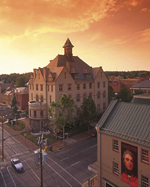
Winchester's downtown includes the beautiful
architecture of such buildings as Rouss City
Hall. |
Making the transition isn’t easy,
but the colorful vision of the townspeople drives Winchester forward.
“Winchester has always been a crossroads, both
geographically and historically,” says Adrian O’Connor, the editorial page
editor of The Winchester Star. The newspaper has been a staple in the
community since 1896. For more than a decade, O’Connor has written a local
history column, learning first-hand of Winchester’s growth from many
perspectives.
“I started talking to old-timers in town, to hear stories
about Winchester from the early to mid-20th century,” he says. “I learn even
the most innocuous details, like where people used to go out to dinner and
how that changes over time.”
At the five-year-old Museum of the Shenandoah Valley, the
administrators understand their audience is diverse, too. The complex
includes an 11-gallery museum showcasing Shenandoah Valley artifacts, the
elegant Glen Burnie Historic House, and six acres of exquisitely landscaped
gardens lush with herbs and vegetables, canopying vines, and trellised
roses.
Glen Burnie was the home of the founder of Winchester,
Colonel James Wood, who came to the area as a surveyor in 1735 and applied
for a 1,200-acre land grant. Eventually, he laid out 26 half-acre lots on
what’s now the walking mall in Old Town Winchester, establishing Frederick
Town, or today’s Winchester.
Years later, Wood’s descendant, Julian Wood Glass Jr.,
inherited Glen Burnie and began renovating the deteriorating house. When
Glass died in 1992, he left the estate to the city of Winchester. Today, the
house is filled with Glass’ expansive collections of furniture and artwork —
by such renowned artists as Sir Joshua Reynolds, Gilbert Stuart, Jean-Baptiste-Camille
Corot, and Rembrandt Peale — as well as his antique china, silver, and
books.
Franny Crawford, the museum’s acting executive director,
says the board has ambitious plans for the Winchester property: “We’ve done
a great job on the inside of the museum. Now we’re focusing on the outside.
We’re beginning to create history and nature trails. And we plan to recreate
a frontier environment with a 1760s cabin, develop outdoor classrooms,
recreate a Civil War encampment, and establish a native wheat field and a
rock garden.”
Fine Arts, Fine Dining
For performing arts patrons, the city offers a local
acting troupe at the Winchester Little Theatre, and both students and
professionals share their talents at Shenandoah University’s Ohrstrom-Bryant
Theatre. The latter is hosting a 2010 Summer Music Theatre schedule that
includes such favorites as Show Boat, Oklahoma! and Seussical.
In the spirit of community, the Little Theatre lends its
parking lot to area farmers to sell freshly harvested produce to locavores
and area restaurants several days a week.
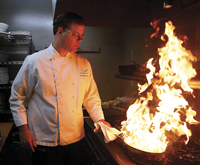
Ed Matthews, the chef and owner of One Block
West, takes advantage of local, seasonal
foods he finds at the farmer's market. |
Ed Matthews, chef and owner of One Block West, routinely
treks to the Farmer’s Market from his upscale bistro near the Old Town
walking mall. On a recent Saturday, he stocked up on locally grown rhubarb,
mesclun, green garlic, and Chinese broccoli. “Asparagus and strawberries are
the gems of May in this area,” he smiles. By July, he’ll horde herbs,
squash, early tomatoes, early stone fruits, and local berries.
“We’re so close to the producers here that we get the
best-quality products before they get to market in the metro D.C. area,”
Matthews explains. “And we have a burgeoning farm-to-table movement that’s
seeing more and more producers and consumers focused on local products. It’s
a great time to be in the food world in Winchester.”
Even with the newfound emphasis on the arts and outdoors
in Winchester, history hounds won’t be disappointed.
On the Old Town walking mall stands the Old Court House
Civil War Museum. Built in 1840, the courthouse was used as a hospital and
prison during the Civil War. Today, an 1800s courtroom is recreated
downstairs (last year, abolitionist John Brown’s trial was reenacted here),
and more than 3,000 Civil War relics are on display upstairs.
“We have one of the best artillery-shell collections
you’ll see anywhere,” brags Maricol Miller, manager of the museum. According
to Miller, the Old Court House is not only a historic landmark but also a
research center, with ongoing exploration into the prisoners who were held
there. Examples of the soldiers’ graffiti are still visible on the walls.
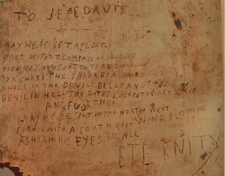
This Civil War graffiti, a curse on
Confederate President Jefferson Davis
scrawled by a captive soldier, can be seen
at Winchester's Old Court House Civil War
Museum. |
One of the most fascinating scrawls is a fiery curse on
Confederate President Jefferson Davis, written in 1863 by a Union prisoner
(forgive the spelling and punctuation): “To Jefe Davis: May here set afloat
a boat without compass or rudder then that any contents be swallowed by a
shark the shark by a whale whale in the devil’s belly and the devil in hell
the gates locked the key lost and further may he be put in the northwest
corner with a southeast wind blowing ashes in his eyes to all eternity.”
Indeed, the passions ran high in Winchester during the
Civil War. Local lore says the town changed hands between Union and
Confederate forces more than 70 times — and, by some accounts, 13 times in
one day!
The grueling First, Second, and Third Battles of
Winchester took place here, as did the First and Second Battles of Kernstown,
the Battle of Cool Spring, and the nearby Battle of Cedar Creek at Frederick
County’s Belle Grove Plantation. Throughout the engagements, Generals Jubal
Early, George Custer, and Philip Sheridan walked Winchester’s streets.
Confederate General Stonewall Jackson actually lived in
Winchester during the winter of 1861-’62. He planned the famous Valley
Campaign from his headquarters in a home on Braddock Street loaned to him by
a local, Lieutenant Colonel Lewis Moore. Today, the home is a museum
displaying Jackson’s family and staff artifacts.
Also open to the public is George Washington’s Office
Museum on Cork Street. Here, a small log building was used as a military
headquarters during the French and Indian War. As commander-in-chief of the
Colonial forces, Washington planned the construction of Fort Loudoun in 1755
and 1756. (The original well remains at the site of the fort on the
outskirts of town.)
Few people realize that Winchester played such a pivotal
role in Washington’s formative years. The first U.S. president arrived in
town at the age of 16 to survey what he then referred to as “a vile
outpost.” Later, he purchased land here and eventually was elected to the
House of Burgesses representing Frederick County, his first political post.
Random Acts of Kindness
Winchester’s beauty and history — and undoubtedly its
resilience — have attracted friends from around the country. The Winchester
Star’s O’Connor points out that the city is “the recipient of the generosity
of a number of people who aren’t even from here.”
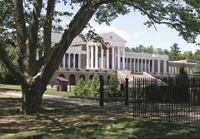
Judge John Handley, a native of Scranton,
Pa., so liked the Winchester area when he
visited that he left part of his fortunes to
build a library -- Handley Regional Library
-- and endow a local school -- now John
Handley High School. |
For instance, Judge John Handley, a wealthy native of
Scranton, Pa., was so enamored with Winchester on a visit that he left his
fortune to endow a large high school and to build a magnificent library,
both architectural masterpieces. Likewise, Charles Broadway Rouss, a
Marylander who attended Winchester Academy in the late 1800s, contributed
large sums of money to fund what’s now Rouss City Hall and the city’s fire
companies.
Possibly the most famous Winchester supporter was Patsy
Cline, born Virginia Patterson Hensley. The Winchester native made her mark
in country music before tragically dying in a plane crash in 1963. According
to O’Connor, she always introduced herself to audiences with the words, “I’m
Patsy Cline from Winchester, Va.” Memories of Cline can be found throughout
the area, from her childhood home on Kent Street, which is undergoing
renovation, to her gravesite on the edge of town. Even Gaunt’s Drugstore,
which boasts employing Cline behind the soda fountain, still pays tribute.
Near the prescriptions counter is an old-fashioned jukebox loaded with Patsy
Cline singles — “Crazy,” “Walkin’ After Midnight,” “I Fall to Pieces” — and
the walls are covered with photos of the singer as she climbed country
music’s ladder.
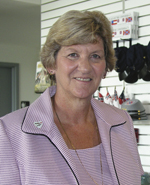
Interim Executive Director of Tourism
Sally Coates says the top three tourist
magnets for Winchester are its Civil War
history, Patsy Cline, and outdoor
activities. |
According to Sally Coates, the interim executive director
of tourism, Patsy Cline fans are a major component of Winchester’s tourist
crowd, second only to Civil War devotees and just outnumbering the influx of
outdoor enthusiasts. But Coates’ personal favorite is Pulitzer Prize-winning
novelist Willa Cather, who was born in Frederick County and who used the
rural setting in her last novel, Sapphira and the Slave Girl.
“In my opinion, Cather is one of the most famous people
who ever came from Frederick County,” says Coates. A Willa Cather exhibit,
sponsored by Winchester-based Shenandoah University, is on display in the
Visitor Center throughout the summer.
The politically prominent Byrd family also has long been
influential in Winchester. Richard E. Byrd, a speaker of the Virginia State
House of Delegates from 1908 to 1912, was editor and publisher of The
Winchester Star. Harry Byrd Sr., one of his three sons, served as governor
of Virginia and later a U.S. senator, while another son, Admiral Richard E.
Byrd II, was a
famous polar explorer. (A statue of the latter graces the
grounds in front of Winchester’s Joint Judicial Center.) Harry Byrd Jr. took
his father’s seat as senator when the former died in 1966 and eventually
took over the reins at the Winchester newspaper.
“Senator Byrd, now 95, still comes to the paper almost
every day,” reports O’Connor. “And he doesn’t just sit around. He lets his
feelings be known,” he adds, laughing. Today, Thomas Byrd, Richard E. Byrd
I’s great grandson, publishes the newspaper.
Winchester 2035
Where will Winchester be in 25 years, as it continues to
meld the old and new?
At the sprawling grounds surrounding the Museum of the
Shenandoah Valley, the organization’s vision places preservation at the top
of its priority list.
“We have 250 acres within our
complex,” explains Director Crawford. “It’s the largest green space in the
city. So it’s part of our job to take care of it, to follow our mission to
‘learn something new, see something beautiful, and protect that which cannot
be replaced.’ I certainly think our settlers came to Winchester and the
Shenandoah Valley because they were drawn to it. Now it’s our duty to
preserve it as best we can.”
|
|
If You Go …
The Museum of the Shenandoah Valley with the Glen Burnie
Historic House and Gardens — An absolute must-see. The museum is eye-opening,
the house is fascinating, and the gardens are gorgeous. Don’t miss the
breathtaking Pleached Allèe and the Pink Pavilion. The Gardens at Night program,
held throughout the warm season, is romantic. A revealing photography exhibit —
“Elvis at 21: Photographs by Alfred Wertheimer” — opens in July. 540-662-1473 or
888-556-5799; www.shenandoahmuseum.org.
Civil War Orientation Center — This educational display area,
complete with maps and guidebooks, is located within the Visitor Center at the
Winchester-Frederick County Convention and Visitors Bureau. 540-542-1326 or
877-871-1326; www.visitwinchesterva.com or www.shenandoahatwar.org.
Stonewall Jackson’s Headquarters — More Civil War history to
soak in at this home loaned to General Jackson during the Valley Campaign. Take
a look at his prayer book and camp table. 540-667-3242;
www.winchesterhistory.org.
The Old Courthouse Civil War Museum — Find more than 3,000
Civil War artifacts, including the largest collection of artillery around. The
museum, located on Winchester’s Old Town walking mall, was a hospital and prison
during the war and offers soldiers’ graffiti-covered walls to prove it.
540-542-1145; www.civilwarmuseum.org.
George Washington’s Office Museum — A tiny piece of real
estate with huge significance in our nation’s history. Washington used this site
to devise his military strategy during the French and Indian War. See artifacts
as well as a bronze statue of a young George Washington who first came to
Winchester as a surveyor. 540-662-4412; www.winchesterhistory.org.
Everything Patsy Cline — Take a self-guided tour that tracks
country music legend Patsy Cline’s life in Winchester: her childhood home; the
FM station where she belted out her first song on the radio; her gravesite. Ask
for your itinerary at the Visitor Center and learn more about Winchester’s plans
to honor Cline. 888-608-2726; www.celebratingpatsycline.org.
Civil War Walking Tours — Organized by the
Winchester-Frederick County Convention and Visitors Bureau, these hour-long
guided meanderings through Old Town Winchester reveal local Civil War secrets.
540-542-1326 or 877-871-1326; www.visitwinchesterva.com.
Shenandoah Apple Blossom Festival — The flagship event in
Winchester, the annual Shenandoah Apple Blossom Festival routinely attracts more
than 200,000 visitors to celebrate the beginning of the apple-growing season,
typically in late April. The weeklong festivities include two parades, a
carnival, the coronation of Queen Shenandoah, and dozens of celebrity-filled
events. Look like a regular: Wear pink and green! 540-662-3863;
www.thebloom.com.
Belle Grove Plantation — This 283-acre farm and Federal-era
manor house was central to the Battle of Cedar Creek and was used by Confederate
General Philip Sheridan as his headquarters during the Valley Campaign. Events
are frequent: An annual reenactment of the Battle of Cedar Creek is held on the
third Wednesday in October; “Of Ale and History,” a daylong festival of
microbrew tasting, occurs each May; and the National Sheepdog Trials come to the
plantation for the first time on September 18 to 26, 2010. 540-869-2028;
www.bellegrove.org.
Rock Harbor Golf Course — Take a break from sightseeing to
play 18 holes on this beautiful course designed among the apple orchards.
866-273-1934; www.rockharborgolf.com.
Shenandoah Valley Discovery Museum — It’s hands-on simple
science for the children in your crowd. A full-sized ambulance is in-house, as
is a Native American hand-harvested home. What fun! 540-722-2020;
www.discoverymuseum.net.
The 2011 Cal Ripken World Series of Baseball — It’s quite a
coup for the Winchester area to land the World Series for 10-year-olds. If
you’re a baseball fanatic, plan to be at Jim Barnett Park on August 13 to 20,
2011, for the Babe Ruth World Series. 540-662-4946; www.winchesterva.gov/parks.
Third Battle of Winchester Bike and Walking Paths — A local
sports store developed a map to guide your bike (and you) on a five-mile trek
through land that once was part of an important Civil War battle. Get your
directions at the Visitor Center. 540.542.1326 or 877.871.1326;
www.visitwinchesterva.com.
|